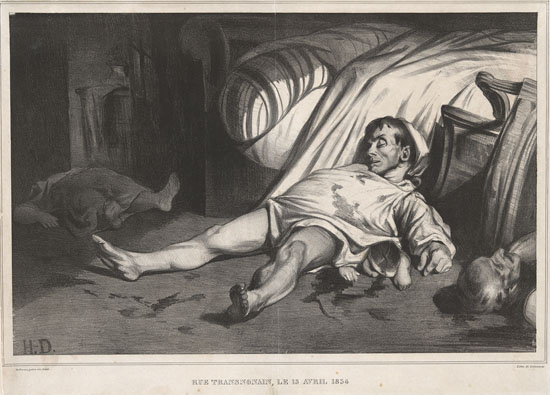
An absorbing subject and What a delightful reading!!, 1836
Daumier displays his virtuoso talent in recording facial and bodily expressions of ordinary folk at an ordinary activity: reading. At the time, he participated in a magazine publisher for the writings of Lavater and gall on human physiognomy and the assessment of character and mental states based on outward form. These prints reveal Daumier's most characteristic treatment of human features: his amazing distortions of the facial mask. It is interesting to note how his comic disproportions are not prohibited by any essential relation of bone and muscle. Daumier's odd faces are not a defiance of structural facts of the human skull, but beautiful expressive exploitations of the face. Through his ingenious and intelligent exaggeration of a facial expression, Daumier shows the myseterious physical effect produced in us by boredome in a man yawning. The drawing of a man having a meal while reading a book caught my attention as the comic exaggerations caused me to burst into laughter. But I soon found myself puzzling over the reason why we should find the misfortunes of others so funny, as we surely must do in the case of the eager reader pouring water onto his food instead of into his glass. I found these two drawings very intriguing despite the seemingly unexciting nature of the subject matter. The unusual choice of the subject matter with his clever humor left me unexpectedly in awe.

Rue Transnonain, 1834
Celebrated as the greatest work of art to come from his crayon, this piece portrays Daumier's anger in response to an atrocity committed by Louis-Phillipe's troops. When the republican workers in Paris rose against the government's imposition of a ban on the right of assembly, the government swarmed in to dismantle the barricades built by working class Parisians. After hearing a gun shot firing from a house on the street, the troops stormed in and killed most of the residents, of whom were mostly old men, women and children. This print is of a exquisite finish, with the richest effects of illumination and "color." The treatment of the face reveals Daumier's gift of expressive lines. This work caught my attention because although this piece could scarcely be called caricature, the deadly silence that followed the violence is still very much powerfully captured without the exaggerated features.
Whether serious or comic, Daumier succeeds in his attempts to express essential character and universal emotions.
Citations:
Farwell, Beatrice. The Charged Image. Santa Barbara: Santa Barbara Museum of Art, 1989. Print.
Daumier, Honore. Rue Transnonain. 1834. Lithograph on paper. The Charged Image. Farwell, Beatrice. California: Santa Barbara Museum of Art, 1989. 57. Print.
Daumier, Honore. An absorbing subject. 1836. Lithograph on paper. The Charged Image. Farwell, Beatrice. California: Santa Barbara Museum of Art, 1989. 58. Print.
Daumier, Honore. What a delightful reading!!. 1836. Lithograph on paper. The Charged Image. Farwell, Beatrice. California: Santa Barbara Museum of Art, 1989. 58. Print.
No comments:
Post a Comment